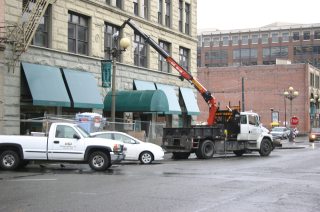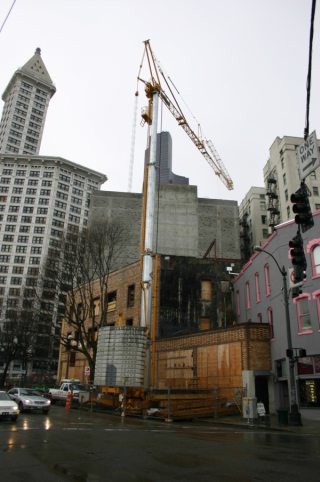
Surveys
Awards
DJC.COM
March 29, 2007
Do you have what it takes to safely operate a crane?
Overton Safety Training
The everyday task of moving materials with the use of overhead hoisting machinery spans all industries, from manufacturing to construction. Today we are fortunate to have an unprecedented selection of mobile, overhead and tower cranes to assist us.
Crane manufacturers are constantly updating and redesigning their products to better fit consumers’ specific needs. We are seeing some drastic changes in the hoisting industry including new ground-breaking products, readdressing established hoisting safety standards, updating professional operator training programs, and revising state and federal codes.
Anytime a load is elevated off the ground there is an inherent risk involved. Mother Nature (gravity) certainly will do as much as possible to return the load back to the ground if we are not fully aware of and follow safe and correct hoisting procedures.
It is easy to paint all mobile cranes with the same brush, with regards to safe operation. However the types and uses of mobile cranes vary greatly by category and design.
For example, companies that deliver building materials may use boom trucks with no hoisting line, may have booms that articulate or are jointed, or may use only pallet-type forks or slings on the end of the boom to engage loads. Their maximum capacity rating is usually only up to 5 tons.
A truss company may use trucks with a straight boom that have a wire rope hoisting line. Some boom lengths may exceed 100 feet or more and are designed to place loads on top of elevated structures. Some boom trucks of this nature have load ratings to 40 tons, although the average is usually around 14 tons.
Mobile rough-terrain and truck cranes may have larger capacity ratings with exceptionally long boom lengths for very high applications. Capacity ratings run from 25 tons up to 300 tons.
Mobile industrial cranes are usually much smaller and designed to be used in a manufacturing environment where doorway clearance is an issue. These machines usually have a smaller capacity of around 6 tons, but may go as high as 10 tons.
It is a good idea to have a basic understanding of crane safety and some form of policies and procedures in place. Consider the following:
Crane selection
Do not ask the equipment to do something it was not designed to do. Never attempt to hoist a load that exceeds the rating of the equipment at that configuration and location. The task involved should be fully understood, load weight known, pick and set-down dimensions known, and crane rating charts referenced.
Trained, certified operator
The required level of experience, training and qualification required will certainly vary by crane type, capacity, the difficulty of the lift, and by actual task involved. Regardless of the type of equipment used, an appropriately trained and qualified operator should be used.
Site preparation and setup
Do a full visual jobsite inspection, including checking and verifying the ground surface, outrigger or stabilizer extension, proper cribbing and/or blocking, setup level, underground-overhead and wind hazards, pedestrian paths, pinch point hazards, and other mobile equipment hazards. Establish requirements for rigging, a signal person and tag line. Also, use appropriate barricades.
Crane pre-use inspection
A full visual equipment inspection includes the wire rope hoisting cable, load block and hook, latch, boom, hydraulics, fittings, outriggers, turntable or rotex, anti-two-block device, Beckett for proper installation, sheaves turning, boom stops, boom slides, engine, belts and all fluid levels.
Crane function check
Check all safety devices and operator aids, cab, wipers, lights, steps, gauges, all boom functions, hoisting winch, boom angle and length indicators, horn, travel and steering (if used).
Plan your load lifting
Check for the correct chart and verify capacity is sufficient. Required information includes the load weight, maximum angle and radius. Also know load handling deductions, clearances, wire rope parts of the line, and hook and rigging capacity.
These vital components are part of everyday crane safety and would generally work for any type of crane. Remember, Mother Nature is always working, and gravity is not our friend when we are hoisting loads.
Ron Overton is president of Overton Safety Training in Aloha, Ore.
Other Stories:
- Local construction market taps on the brakes
- New program pays you for energy-efficient buildings
- WSDOT tracks DBE participation over the Web
- Design-build construction offers risk relief
- It’s a global contest for skilled workers
- Local housing market still cooking
- Taking the fear out of state excise tax audits
- When insurers see clean dirt as a pollutant
- Negotiating a contract? Try this checklist
- In marketing, nothing beats a face-to-face meeting
Copyright ©2009 Seattle Daily Journal and DJC.COM.
Comments? Questions? Contact us.

